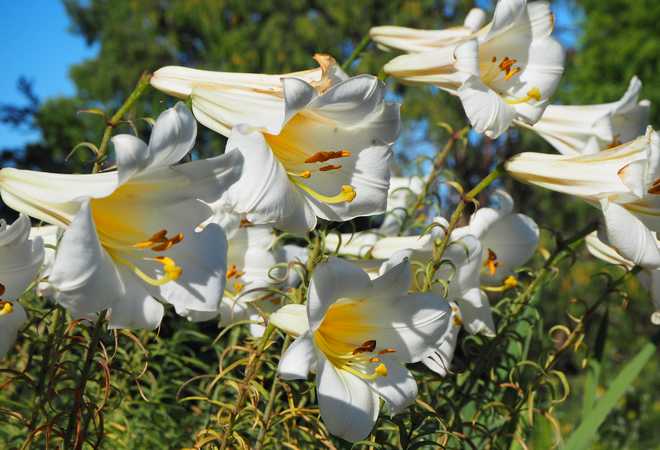
Indispensable in a flower garden with bouquets, the royal lily is the most widespread of the lilies. This majestic perennial , very floriferous, is native to western China.
What there is to know :
Botanical name : Lilium regale
Common name : royal lily, royal lily
Family : Liliaceae
Height x spreading: 1.20 m to 1.50 m
Foliage : the narrow, linear and dark green leaves are staged over the entire length of the stem. Rigid, robust, this stem firmly attaches to the bulb.
Bulb : The bulb is made up of fleshy scales and measures 16 to 25 cm in circumference. Many aerial bulblets are produced.
Flowers : In July and August, the elongated purple-pink buds open into large, very fragrant, trumpet-shaped flowers. They are pure white in Lilium regale Album. The heart of the flower is yellow, its stamens orange, and the reverse often tinged with carmine.
Exposure : in the sun or in partial shade in a hot climate
Soil : cool in summer, well drained in winter, the royal lily fears excess humidity. Any good garden soil, rich, rather neutral, neither too acid nor too calcareous, is suitable for it.
Hardiness : -20°C, the bulb does not freeze. This perennial can stay in place for years.
Sowing and planting the royal lily
Sow the seeds in the spring. But the small lilies obtained in this way will bloom only after 4 years.
Bulbs are more conventionally planted in the spring:
- Plant 4 to 5 bulbs in groups, spacing them 30 cm in all directions. The large bulb of the royal lily should be buried 15-20 cm deep because the plant develops adventitious roots on the buried part of the stems.
- Mix one or two handfuls of sand with the soil to lighten it, improve its drainage and prevent any risk of bulb rot in winter. You have to find a balance: if lilies do not like dry soil, they are also very sensitive to excess humidity!
- Mulch with compost to enrich the soil and dry grass clippings to maintain freshness.
- Avoid competition from overly vigorous perennials nearby.
During the spring, you can also replant bulbs purchased in containers from a garden center.

Royal Lily Care
Watering : Lilies like to keep their feet cool. Water very regularly to keep the soil moist, without excess, from the start of growth to the fall of the leaves.
Fertilization : Lilies are greedy. Each year, when the bulb starts up again in the spring, bring a shovel of compost and a handful of roasted horn and dried blood that you spread around the budding stem. Claw to incorporate it into the first centimeters of soil.
Pruning : After flowering, remove faded flowers to focus the plant’s efforts on replenishing the bulb’s reserves. During the winter, leave the bulb in place, it will go through the bad season without any problem.
Stake : Stake discreetly in the spring. The ideal is to leave this tutor 20 to 30 m below the flowers.
Associations with the royal lily
This majestic perennial can take place in all gardens, both in French-style beds and in a Hispano-Moorish flowerbed. It is also one of the favorite flowers when you want to create a fragrant garden.
In a clump, combine the royal lily with perennials and annuals that flower in the summer and do not compete with it: baby’s breath, bellflowers , Delphiniums , superb Gauras or even perennial geraniums.
Pot culture of the royal lily
Its pot culture is possible , provided you choose a large container 20 to 30 cm in diameter:
- In this case, the lily is rather planted in autumn.
- Use a mixture of rich potting soil, good garden soil and sand.
- Lay out a draining layer (5 cm of gravel or gravel) at the bottom.
- Very regular fertilizations (once a month) are essential throughout the growing season.
Royal Lily Diseases
Leaves and flowers can be deformed by a fairly common virus in lilies. There is no treatment: the bulbs must be pulled out. Do not replant them in the same place. In prevention, collect in the fall and eliminate all waste from the plant: leaves and dry stems.
The lily leaf beetle is a fearsome beetle pest. Its larvae eat the leaves and then the flowers in the spring. Watch for the appearance of small black droppings. Treat with black soap.
How to cut Lilium regale?
In September, after flowering, a cutting of the scales of the bulb is practiced .
- Release a bulb.
- Detach one or more scales.
- Quickly soak in a container of Bordeaux mixture (fungicide).
- Leave to dry flat for a few hours.
- Install them in a transparent plastic bag containing moist potting soil.
- Close it by inflating it with air and keep it inside the house (20°C)
- After about a month and a half, small bulbs appear at the base of the scales.
- Transplant them into pots, leaving the scales protruding 2-3 cm.
- Keep them cool but frost-free all winter.
- In the spring, you can replant them in their final place. It will take between 2 and 5 years to see them bloom for the first time.
Fall is also a good time to transplant an already established royal lily.
Did you know ?
The royal lily becomes more floriferous each year as its bulb grows. 1 single bulb can offer up to 30 flowers!
The vanilla, heavy and heady scent of this flower diffuses exotic and tropical notes. Feel free to include it in stunning bouquets. To make flowers last longer and prevent pollen from soiling your furniture, remove the stamens.
The fleur-de-lis (or Lys) has been the emblem of the Kings of France since the 12th century, hence the name given to this perennial.
The white lily also plays an important role in Christianity where it symbolizes the purity of the Virgin Mary.
